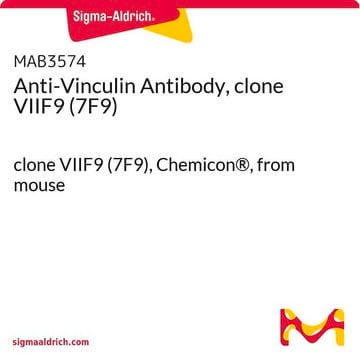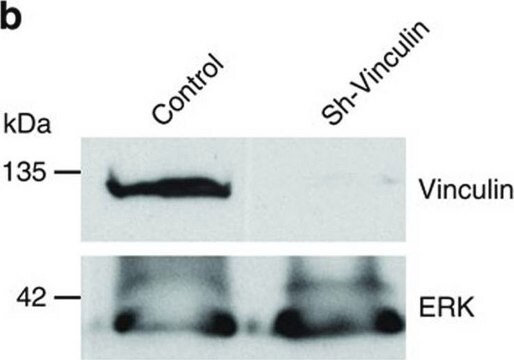F7053
Anti-vinculina monoclonal
clone hVIN-1, purified from hybridoma cell culture
Sinônimo(s):
Monoclonal Anti-Vinculin antibody produced in mouse
Selecione um tamanho
Selecione um tamanho
About This Item
Produtos recomendados
fonte biológica
mouse
Nível de qualidade
conjugado
FITC conjugate
forma do anticorpo
purified immunoglobulin
tipo de produto de anticorpo
primary antibodies
clone
hVIN-1, monoclonal
Formulário
buffered aqueous solution
peso molecular
antigen 116 kDa
reatividade de espécies
frog, chicken, mouse, canine, human, bovine, rat, turkey
condição de armazenamento
protect from light
técnica(s)
direct immunofluorescence: 1:50 using methanol/acetone fixed cultured bovine MDBK cells
Isotipo
IgG1
nº de adesão UniProt
Condições de expedição
dry ice
temperatura de armazenamento
−20°C
modificação pós-traducional do alvo
unmodified
Informações sobre genes
human ... VCL(7414)
mouse ... Vcl(22330)
rat ... Vcl(305679)
Procurando produtos similares? Visita Guia de comparação de produtos
Especificidade
Imunogênio
Aplicação
Ações bioquímicas/fisiológicas
forma física
Exoneração de responsabilidade
Não está encontrando o produto certo?
Experimente o nosso Ferramenta de seleção de produtos.
produto relacionado
Código de classe de armazenamento
12 - Non Combustible Liquids
Classe de risco de água (WGK)
nwg
Ponto de fulgor (°F)
Not applicable
Ponto de fulgor (°C)
Not applicable
Escolha uma das versões mais recentes:
Já possui este produto?
Encontre a documentação dos produtos que você adquiriu recentemente na biblioteca de documentos.
Os clientes também visualizaram
Active Filters
Nossa equipe de cientistas tem experiência em todas as áreas de pesquisa, incluindo Life Sciences, ciência de materiais, síntese química, cromatografia, química analítica e muitas outras.
Entre em contato com a assistência técnica

















